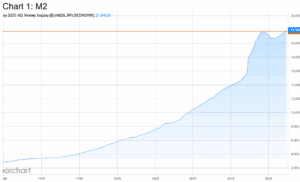Key takeaways
Rising yields
Last week, the 10-year US Treasury yield rose to levels not seen since 2008, and that had significant implications for stocks.
Consumer sentiment
I was encouraged by what we heard on earnings calls for major retailers last week, as they confirmed my positive views on consumer behavior.
Federal Reserve
I expect Fed policymakers to err on the side of hawkishness at their symposium in Jackson Hole later this week.
Last week the 10-year US Treasury yield rose to levels not seen since 2008, and that had significant implications for stocks, exerting a powerful gravitational force that helped push them lower.1 That stands to reason. Though it has not always been the case, we might expect that when yields go up, stocks would tend to go down as bonds become more attractive to investors relative to stocks and earnings multiples contract. But what prompted this rise in yields, and how should we view this in the context of other market signals? And what might we hear from the Federal Reserve (Fed) this week? Here’s how I’m thinking about the latest developments.
Why did US Treasury yields rise?
On a very simple level, this could merely be viewed as a case of supply outstripping demand. In fact, in a blog earlier this month, I wrote that we could see Treasury yields rise because of several different factors including: 1) The alterations to the Bank of Japan’s yield curve control policy make US Treasuries less attractive to Japanese investors because of a reduced yield differential; 2) the US is planning to issue a significant increase in Treasuries now that the debt ceiling crisis has been resolved; and 3) the recent Fitch Ratings downgrade of US credit.
However, economic theory posits that bond yields for advanced economies can be decomposed into two components: Real yield and breakeven inflation. Breakeven inflation is simply a market-based measure of inflation expectations, while the real yield is viewed as a reflection of growth expectations. So if breakeven inflation remains static or even declines, then a rise in the Treasury yield can be assumed to reflect growth expectations.
We are seeing this happen now. It seems that the recent rise in Treasury yields reflects improved growth expectations, as fears about recession have subsided — and as inflation data continues to show improvement and survey-based inflation expectations have fallen.
A “bear steepener” complicates the bigger picture
We need to take a step back and look at the bigger picture, which is that long rates have been rising faster than short rates. This phenomenon is called “bear steepening” and it doesn’t typically bode well for the economy.
Now it is important to note that the “bear” in bear steepening refers to bonds rather than stocks, as investors tend to avoid the long end of the curve more than the short end, sending long yields higher. An extended period of bear steepening is relatively rare and is usually associated with concerns about rising inflation. Conventional wisdom suggests that central banks will have to become more hawkish because of rising inflation. This makes long-term bonds less attractive, causing demand for them to drop and yields to rise.
Periods of bear steepening of the yield curve are relatively rare but have tended to precede recessions. However, that is not always true. One example of a bear steepener that didn’t result in recession and was accompanied by a bullish stock market occurred from July 2020 to March 2021. Two-year Treasury yields barely increased but they did rise, while 10-year Treasury yields increased significantly.2
Also, as pointed out above, we have to try to understand what is causing the rise in yield on the long end of the curve. This time around, it’s likely being driven by improved growth expectations — which suggests this bear steepener may not be signaling trouble ahead. In fact, it could suggest expectations that the Fed actually has been successfully able to control inflation without ruining the economy, which could mean expectations of no rate cuts any time soon.
What does this all mean?
There is legitimate concern that the Fed is too worried about inflation and will continue to tighten. The minutes from the July Federal Open Market Committee (FOMC) meeting were perceived as more hawkish. Gas prices are rising in the US, which can cause consumer inflation expectations to increase, and we know the Fed pays attention to such measures. And we saw a recent inflationary resurgence in Canada (and often Canadian inflation data can be predictive of where the US is headed). However, I continue to believe we’re in a strong disinflationary trend, with some hiccups likely along the way.
Suffice it to say that we are getting some confusing market signals. However, no market signal is infallible, and we need to look more holistically at the economic environment. I’m seeing more positive than negative developments. As I noted last week, US inflation data has been improving, and so have survey-based inflation expectations, which matter to monetary policymakers.
Earnings calls highlight positive consumer sentiment
I was also encouraged by what we heard on earnings calls for major retailers last week, as they confirmed my views on consumer behavior.
- Target CEO Brian Cornell noted that consumers have money to spend, but they continue to focus spending on services rather than goods: “Guests are out at concerts, they are going to movies … they are enjoying those experiential moments and are shopping very carefully for discretionary goods.”3
- Home Depot CEO Ted Decker said that consumer sentiment is rather positive: “Fears of a recession, or at least a severe recession, have largely subsided, and the consumer is generally healthy…”4 And that is supported by recent University of Michigan consumer surveys. The preliminary August estimate of consumer sentiment was 71.2, down slightly from the July reading of 71.6 but still relatively high (the July reading was the highest since October 2021).5
The lagged impact of policy tightening casts a shadow
But corporate executives also recognize there is significant uncertainty about the future given the aggressive monetary policy tightening that has occurred. Home Depot’s Decker explained: “But given all those positives … uncertainties remain … And we don’t know how the monetary policy actions, which are specifically intended to dampen consumer demand, what that impact will ultimately have on consumer sentiment in the overall economy.”4
And that’s all the more reason for the Federal Reserve to sit on its hands and wait to see the lagged effects of its policy tightening. There is certainly apprehension about what might be said at the Fed’s symposium in Jackson Hole this week (in speeches and interviews), but we have to recognize that Fed policymakers are likely to err on the side of hawkishness in their communications because of their need to prevent financial conditions from easing and be able to avoid any more rate hikes.
Hopefully they will take a more cautious position when it comes to policy actions. As we wait and see, and get lots of Fed-speak, I would anticipate some market jitters.
With contributions from Paul Jackson
Footnotes
- 1Source: Bloomberg, L.P. as of Aug. 18, 2023
- 2Source: Bloomberg, L.P. as of March 31, 2021
- 3Source: Target earnings call, Aug. 16, 2023
- 4Source: Home Depot earnings call, Aug. 15, 2023
- 5Source: University of Michigan Survey of Consumers, Aug. 11, 2023
—
Originally Posted August 21, 2023
As US Treasury yields weigh on stocks, what will the Fed say next? by Invesco US
Important information
NA3074259
Past performance is not a guarantee of future results.
This does not constitute a recommendation of any investment strategy or product for a particular investor. Investors should consult a financial professional before making any investment decisions.
All investing involves risk, including the risk of loss.
In general, stock values fluctuate, sometimes widely, in response to activities specific to the company as well as general market, economic and political conditions.
Fitch Ratings is a leading provider of credit ratings, commentary, and research for global capital markets.
The Survey of Consumers is a monthly telephone survey conducted by the University of Michigan that provides indexes of consumer sentiment and inflation expectations.
Tightening monetary policy includes actions by a central bank to curb inflation.
A multiple is any ratio that uses the share price of a company along with some specific per-share financial metric to measure value. Generally speaking, the higher the multiple, the more expensive the stock.
The Bank of Japan‘s yield curve control policy seeks to fix yields on 10-year Japanese government bonds around zero, tolerating moves of up to 50 basis points above or below that level.
The yield curve plots interest rates, at a set point in time, of bonds having equal credit quality but differing maturity dates to project future interest rate changes and economic activity.
The Federal Open Market Committee (FOMC) is a 12-member committee of the Federal Reserve Board that meets regularly to set monetary policy, including the interest rates that are charged to banks.
The opinions referenced above are those of the author as of August 21, 2023. These comments should not be construed as recommendations, but as an illustration of broader themes. Forward-looking statements are not guarantees of future results. They involve risks, uncertainties and assumptions; there can be no assurance that actual results will not differ materially from expectations.
Disclosure: Invesco US
This does not constitute a recommendation of any investment strategy or product for a particular investor. Investors should consult a financial advisor/financial consultant before making any investment decisions. Invesco does not provide tax advice. The tax information contained herein is general and is not exhaustive by nature. Federal and state tax laws are complex and constantly changing. Investors should always consult their own legal or tax professional for information concerning their individual situation. The opinions expressed are those of the authors, are based on current market conditions and are subject to change without notice. These opinions may differ from those of other Invesco investment professionals.
NOT FDIC INSURED
MAY LOSE VALUE
NO BANK GUARANTEE
All data provided by Invesco unless otherwise noted.
Invesco Distributors, Inc. is the US distributor for Invesco Ltd.’s Retail Products and Collective Trust Funds. Institutional Separate Accounts and Separately Managed Accounts are offered by affiliated investment advisers, which provide investment advisory services and do not sell securities. These firms, like Invesco Distributors, Inc., are indirect, wholly owned subsidiaries of Invesco Ltd.
©2024 Invesco Ltd. All rights reserved.
Disclosure: Interactive Brokers Third Party
Information posted on IBKR Campus that is provided by third-parties does NOT constitute a recommendation that you should contract for the services of that third party. Third-party participants who contribute to IBKR Campus are independent of Interactive Brokers and Interactive Brokers does not make any representations or warranties concerning the services offered, their past or future performance, or the accuracy of the information provided by the third party. Past performance is no guarantee of future results.
This material is from Invesco US and is being posted with its permission. The views expressed in this material are solely those of the author and/or Invesco US and Interactive Brokers is not endorsing or recommending any investment or trading discussed in the material. This material is not and should not be construed as an offer to buy or sell any security. It should not be construed as research or investment advice or a recommendation to buy, sell or hold any security or commodity. This material does not and is not intended to take into account the particular financial conditions, investment objectives or requirements of individual customers. Before acting on this material, you should consider whether it is suitable for your particular circumstances and, as necessary, seek professional advice.
Disclosure: Futures Trading
Futures are not suitable for all investors. The amount you may lose may be greater than your initial investment. Before trading futures, please read the CFTC Risk Disclosure. A copy and additional information are available at ibkr.com.




















Join The Conversation
For specific platform feedback and suggestions, please submit it directly to our team using these instructions.
If you have an account-specific question or concern, please reach out to Client Services.
We encourage you to look through our FAQs before posting. Your question may already be covered!